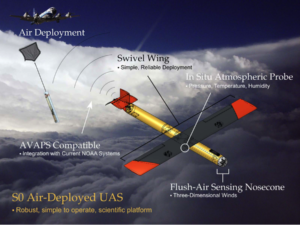Drones have become a major tool for weather researchers, including the National Oceanic and Atmospheric Administration (NOAA). NOAA has used drones to capture killer whales on film, forecast wildfires, and research hurricanes.
Now, Black Swift Technologies, an engineering firm, is developing a drone swarm that will be deployed close to the eyewall of a cyclone or hurricane in order to gather critical data for scientists. As storms gain in intensity across the U.S., hurricane research remains a critical focus for scientists.
The following is a Black Swift Technologies press release.
Black Swift Technologies (BST), a specialized engineering firm based in Boulder, CO, announced today it has been awarded a NOAA contract to develop an air-deployed unmanned aircraft system (UAS) to perform lower boundary layer observations in difficult atmospheric conditions that are commonly encountered in convective storms, e.g. hurricanes and tropical cyclones.
BST is proposing a vehicle, called the S0 Air-Deployed UAS, that can be tube-launched from an aircraft, such as NOAA’s Lockheed P3 Orion (Figure 1). The design of the S0 UAS system is intended to mimic the operations of radio dropsondes already used by NOAA in these environments, reducing the workload of the operators and keeping with the current overall CONOPS. BST’s goal is to provide a cost-effective, air-launched UAS designed to augment pressure, temperature, humidity and sea surface temperature measurements, with 3D wind data. The S0 UAS is designed to provide intelligent and autonomous extended sampling (1+ hour of targeted observations) where the aircraft can make its own navigation decisions based on the atmospheric sensor data.
Key to the effectiveness of this strategy is BST’s ability to use AVAPS™ (Airborne Vertical Atmospheric Profiling System) for long-range backhaul of the science data, guaranteeing transmission at the current operational ranges for the dropsondes. In making use of the AVAPS system means that no communications need be sent to the UAS after release without the addition of a separate command and control link. The vehicles are intended to be deployed close to the sea-surface and eyewall of the storm to capture essential data. BST designed custom avionics enabling the UAS to fly autonomously in a turbulent environment while integrating critical components including those necessary for 3D wind sensing along with interfaces to the RD-41 sonde and radio. As the vehicle will not be recoverable, it’s essential that the data is relayed in its entirety during the flight.
“With the destructive force demonstrated by hurricanes in 2018 (Florence and Michael in particular), hurricane forecasting remains a priority for scientists researching and striving to predict the paths and intensities of these storms,” states Jack Elston, Ph.D., CEO of Black Swift Technologies. “Our solution leverages technology and communication protocols NOAA has demonstrated effective, while our simplified design keeps the cost of the aircraft to a minimum, ensuring that multiple vehicles can be deployed for each storm, dramatically increasing the amount and accuracy of the data captured.”
About Black Swift Technologies
Founded in 2011, Black Swift Technologies LLC, develops custom unmanned aircraft system (UAS) solutions leveraging the SwiftCore™ Flight Management System (FMS) consisting of the SwiftPilot™ autopilot system, the SwiftTab™ tablet-based user interface, the SwiftStation™ ground station, and application specific sensor integrations. The SwiftCore™ FMS is designed to be modular, robust, and simple to operate allowing users to focus on data products.
In addition to the SwiftCore FMS, Black Swift Technologies has unique capabilities to develop and deploy advanced small unmanned aircraft systems (UAS) due the team’s combined expertise in the design, implementation, and analysis of advanced “smart” control systems, expertise in legal and safe flight operations in the United States airspace, and their practical experience and knowledge from thousands of hours of UAS flight operations in demanding conditions. The SwiftCore FMS enables advanced control systems. These “smart” control systems provide industry leading sensor-based control of the UAS that minimizes operator workload while improving the quality of the observed data by autonomously modifying the flight path based on sensor inputs.
More information on Black Swift Technologies and their suite of sUAS solutions can be found at: bst.aero.

Miriam McNabb is the Editor-in-Chief of DRONELIFE and CEO of JobForDrones, a professional drone services marketplace, and a fascinated observer of the emerging drone industry and the regulatory environment for drones. Miriam has penned over 3,000 articles focused on the commercial drone space and is an international speaker and recognized figure in the industry. Miriam has a degree from the University of Chicago and over 20 years of experience in high tech sales and marketing for new technologies.
For drone industry consulting or writing, Email Miriam.
TWITTER:@spaldingbarker
Subscribe to DroneLife here.








[…] L’articolo completo è qui […]